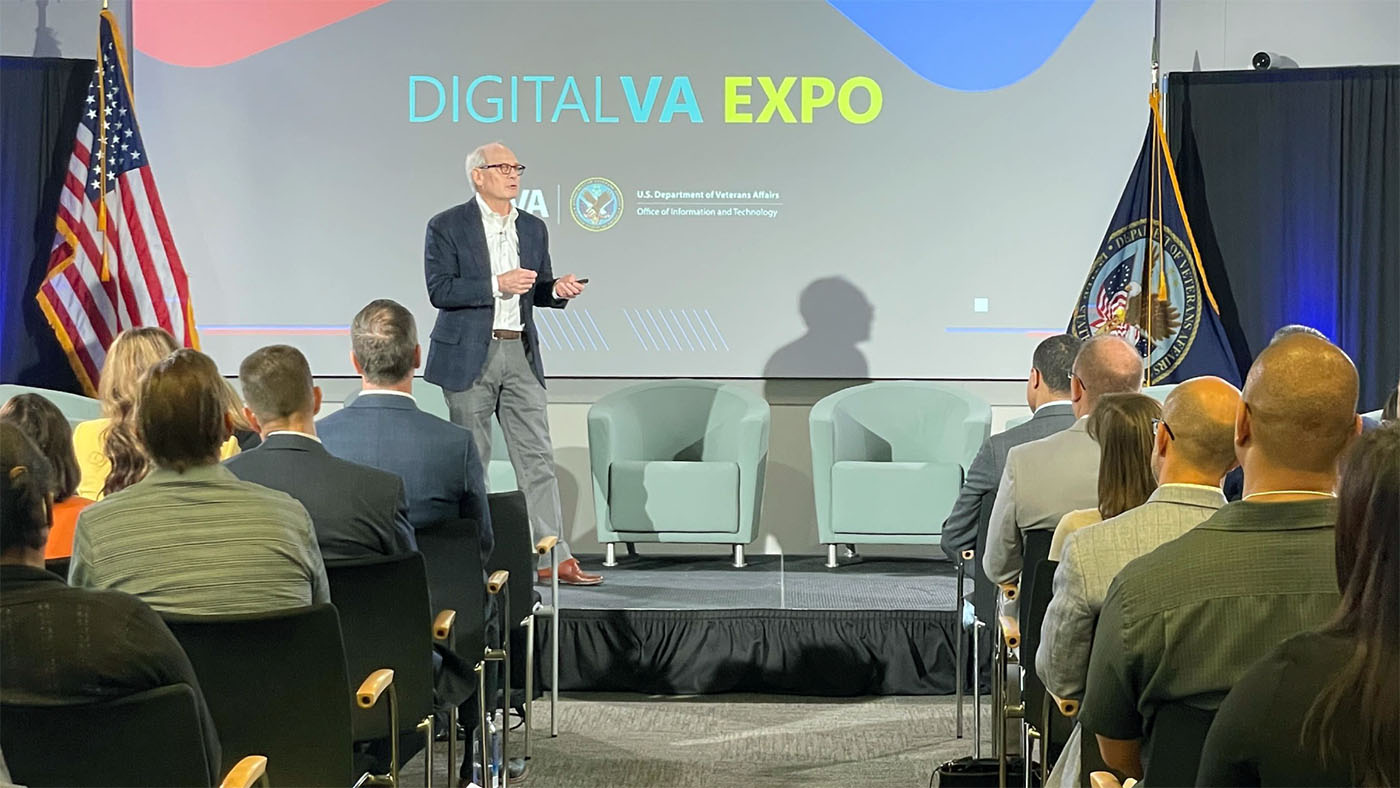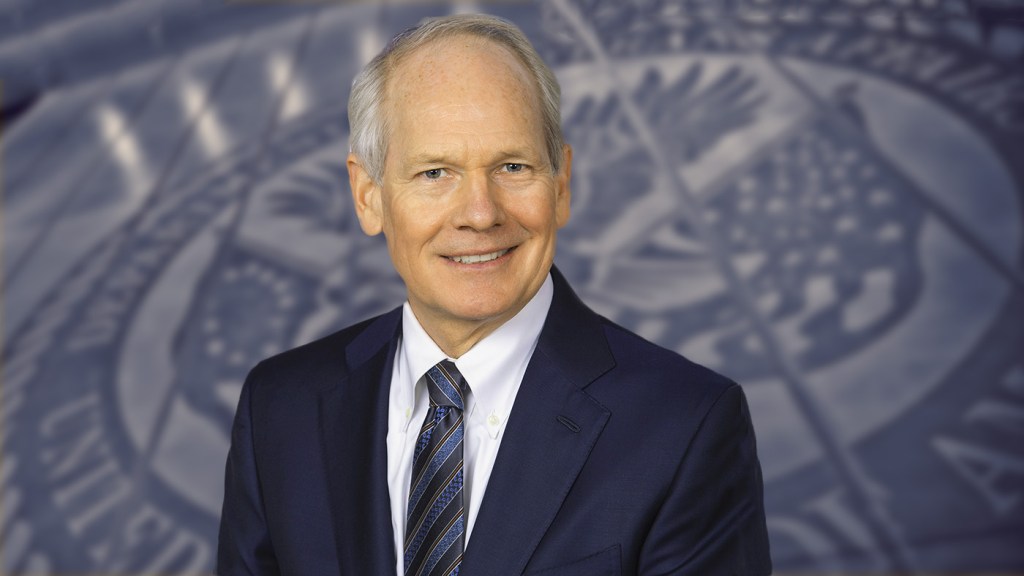I’ve had the opportunity to present our digital transformation journey to a range of stakeholders across regions and industries, including at this summer’s Digital VA Expo in Palo Alto.
I’ve always believed that it’s not enough to drive digital transformation; we also need to effectively tell the story of our progress and how far we have come in delivering world-class IT products and services to our nation’s Veterans.
As I’ve presented our story and engaged in discussions, I’ve been struck by how many of us in the federal and commercial IT space grapple with similar challenges — aging infrastructure, projects that don’t end well, difficulty hiring enough great people. These problems plague us all. At the end of the day, I believe today’s IT organization must operate as a technology product group, and our success depends upon putting the right teams in place, giving them the tools they need to do the job, communicating to them the vision of where we need to go, and then getting out of their way.
Assuring Product Success
Doing this effectively starts with having a great team — and VA does. There’s one role in particular that provides the critical glue that sets the team off in the right direction: the product manager. These are the folks that set the product direction, prioritize the features, build the release plans, track our progress, and make dozens of course corrections along the way. If you have a great set of product managers on your team, you can have confidence that the product will be headed in the right direction and that the team will continually build great solutions that meet end user needs and that operate reliably. They are key leaders that assure a product’s success.
If you scan through USAJobs, you might find far more job postings that mention “project” and “program management,” but not as many opportunities for product managers. This is in part due to the way that we tend to blur terms and use “product” and “project” interchangeably. It also reflects the evolution I believe needs to happen in the federal IT space.
IT project managers and program managers manage the nuts and bolts of a product release. Product managers do this as well, but they also think “one click up” to see left to right across all the issues a program faces and make sure the entire effort is heading in the right direction. I believe program and project managers should strive to become great product managers, regardless of their job title.
Great product managers are highly sought after. Industry has an advantage with respect to being able to offer profit-sharing or performance-based incentives that are rare in the government space. Yet we have our own advantages to offer — most notably, our unique mission of serving our Veteran community and, in the process, improving their daily lives through technology. After having spent time in both worlds, helping others as we do at VA is just better. 😊 Moreover, if you’ve been successful in your commercial career and are searching for a way to “give back,” there’s no better place to do so than VA.
Building Great Products and Experiences
We’ve all grown accustomed to doing business digitally, and our Veterans are no different. They expect a user experience that is intuitive and easy, whether it’s accessing life-changing benefits or securing final resting places. The things we build to enable these services are products as much as your favorite piece of tech is a product.
For example, we build bespoke systems to process veteran benefits claims. That system, VBMS, has a customer base just like an iPhone or Android phone does. These customers have functionality expectations. They have expectations on uptime and resiliency. The project has an available budget for development, which necessitates prioritization tradeoffs. In every way, it’s as much a “product” as your smartphone is.
Our industry has come to the realization that even end user desktop support is a product. The customer wants a highly reliable desktop computing experience with certain features. They expect that system to work reliably and with good performance. They expect that “product” to get better every year in ways that explicitly and implicitly consider their current experience. So again, the desktop that we deploy and support is as much a product as the smartphone we carry in our pockets.
Just as the vision for that flagship smartphone is defined and shepherded by great product managers, we must have great product managers to create great products in IT for our users as well. So, we might ask the question: What does a great product manager look like?
Customer Obsession: Just as in the private sector, a great product manager in government, especially at VA, is super-focused on the most critical unmet needs of end-users — Veterans, citizens, public servants, or other stakeholders. She lives and breathes the pain points and requirements of these users every moment of every day. She seeks to create delightful experiences that exceed expectations of the Veterans that we serve. She feels personally invested and owns the products she helps to build, obsessively focused on making it better. She seeks out and leverages tools that will help the team deliver on these needs, such as structured product feedback and human-centered design principles.
Long-term Vision: Great federal product managers have a clear, long-term vision for how the products and services he oversees align with the organization’s mission and long-term vision. In all aspects of our work, our vision guides how we execute our work. As Secretary McDonough has said, our digital experience should aspire to nothing less than “the most innovative, reliable, and customer-focused experience — not just in the government, or the American private sector … but in the world.” The visions the product manager creates are at just the right altitude. When you read them, they are aspirational, but you can clearly see what’s in scope and out of scope. You can envision what practical investments will help to achieve the vision. You can imagine the execution plan and the tradeoff decisions the team will confront along the way.
Data-driven Decision-making: Data-driven decision-making is foundational for continual improvements in delivering any product or user experience. Product managers increasingly must have access to the right tools and insights for understanding the impact of their work. They must cultivate the ability to collect, analyze, and leverage data for evaluating the performance of our programs and services, allowing us to make course corrections and pivot when the trendlines warn us of pain points. They spec the listening systems as part of the product. (We’re doing our part at OIT by investing in our data and data analytics portfolio to enable decisions across the organization that are tied to clear metrics and data-driven choices.)
Practices Ruthless Prioritization: Great product managers know that resources are scarce, and time is short to deliver on innovations that our user desperately need. That’s why they have a clear prioritization of the product features and enhancements. They constantly question whether an investment is worth it. They actively seek out investments that are low priority or that have only a vague connection to serving the customer, so they can help sunset that work and redeploy the resources to higher priority work.
Considers the Path to User Adoption in All They Do: I can’t tell you the number of times I’ve sat in product reviews where a product manager walked through the pet feature they’ve been working on for months and wondered, “How the heck will someone ever find this feature to use it?” In contrast, great product managers think about this question from the outset. They build features that don’t require documentation to find and often don’t require documentation to use. When they do, great product managers know what training will be required and reach out to the training teams to collaborate with them to create great training, available when the feature ships.
Invests in Continuous Engineering Improvement: Great product managers care deeply about driving engineering improvement both in their products and in their processes. They understand the value and criticality of investing in system modernization on an ongoing basis to avoid obsolescence. They continuously diagnose how they build, deploy, and operate their products, looking for ways to decrease downtime, improve end user responsiveness, and reduce system costs.
Strong Technical Understanding and Intuition: Product managers don’t need to know how to write software or design hardware, although it’s an asset if they do. They do need to understand the technology landscape sufficiently well to have informed discussions with the development teams on product direction. They must be able to intuit what change would be hard to implement vs. easy. They must be able to see the telltale signs of a product that’s in trouble and in need of intervention/reset. These skills are particularly important in the US government, where the software development function is often outsourced to contractors. Outsourcing doesn’t mean absolution from responsibility that a project goes well. It means product managers are deeply engaged, understand the work deeply, and intervene early when things start going off course.
Strong Communication and Collaboration Skills: Our line of work requires that we communicate clearly and work effectively with others, whether that’s a Veteran, colleague, advocate, or a Hill staffer. As we keep breaking down siloes across OIT, collaboration increasingly requires that we work in an interdisciplinary way, including with colleagues we may not have formal authority over but still depend on to get things done. The most effective product managers seek out other teams involved in delivering the product, discuss challenges (aka “embrace the red”), and directly influence outcomes even when they don’t have formal authority. Being accountable but not having complete responsibility over directing the resources they need is seen as a challenge, not a barrier. They understand, thrive, and get things done in this complex environment.
Continuous Learning: In a rapidly evolving landscape of technology and government processes, we all need to practice continuous learning and stay current with industry best practices — all of us, not only product managers. Agility enables us to adapt to changing environments and adopt innovative solutions. My view is that product professionals should continue to make their own development a priority and invest in new capabilities, including emerging areas like iterative development, design thinking, and successfully delivering prototypes of new products.
Taken together, being a great product manager is both a challenge and a huge opportunity. By being our best, we focus our investment clearly on the target and we deliver for our stakeholders — the estimated population of more than 18.5 million Veterans across the country with 9 million+ total enrollees in the VA health care system, as well as 5.6 million Veterans receiving VA disability compensation.
With so many Veterans among our ranks and a universal appreciation of what our military does each day for our country, I’ve seen firsthand that our mission is sacred to each member of our team — including the outstanding product managers among our ranks.



